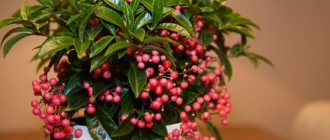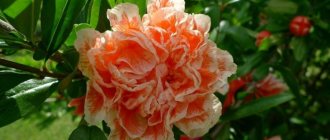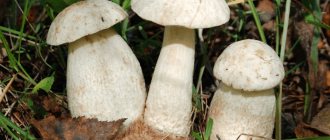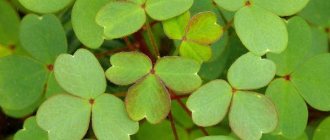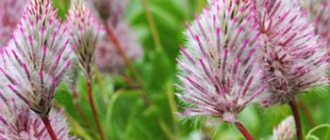The fern flower is a mythical flower that reveals to its owner the treasures and secrets of the world, granting clairvoyance and power over the evil spirit.
According to Slavic beliefs, the fern blooms only for one moment, on the night before Ivan Kupala (June 24 [July 7]).
It is very difficult to pick a flower, especially since evil spirits prevent this in every possible way and intimidate a person, in some cases depriving him of reason, speech, and memory.
In reality, the fern is not capable of blooming. It belongs to fern-like plants that reproduce through spores.
Description of the plant
Photo:
Fern is a herbaceous plant belonging to the Osmundaceae family, genus Fernaceae. The homeland of the plant is Northern China, Korea, and the Far Eastern Russian region.
Distributed in Russia, Ukraine, Finland, and Central Asia. It is a green stem with numerous feathery dissected leaves. The fern reproduces only through spores and does not bloom.
Interesting. Ferns are considered one of the most ancient plants on the planet, which appeared in the Devonian period of the Paleozoic era. The wood of the plant later became a source of coal.
It is believed that this plant is a descendant of the first plants on the planet - rhinophytes. Their branches gradually turned into leaves, and the spores moved from the end of the branches to the underside of the leaf.
The process of spore emergence and maturation is very similar to the growth of flowers. The plant is collected all summer.
Today there are thousands of species of ferns.
Structure, flowering
The fern trunk is smooth and has no scales. The root system is powerful. The root is a creeping root; buds are formed on it, from which young shoots are formed.
Stepchildren appear from the ground at a distance of 10 to 20 cm. Initially, they have a snail-like head, which gradually turns into leaves.
Sporulation is the main method of fern propagation. The spores grow on the back of the leaf. As the spore capsule matures, it cracks and the spores scatter in the wind.
As soon as they fall on favorable fertile soil, they begin to grow.
During the growth of the spore, a prothallus is formed in the form of a small green cup. Sperm and eggs appear on the reverse side of the growth.
After fertilization of the egg, germination of the seed begins, and the stepson begins to take root. The fern forms a bush over several years. Fern blossoms are impossible.
Vegetative propagation of fern is possible. At the same time, long arrows are formed on the bush. They bend down to the kidney and are pressed down by the stone.
Such reproduction is also carried out by humans in a garden or summer cottage. The arrow takes root in the ground. For replanting, a fragment of earth is dug up along with the root system.
Ferns also reproduce by division. In early spring it must be removed from the ground. Dense roots are washed from the ground with water, divided into shoots, which are then transplanted to another area.
What is called leaves in everyday use is called fronds in science. They are able to grow in length for a long time. Fronds take an active part in photosynthesis and plant reproduction.
The bark of the stems acts as a support. Ferns do not have a cambium, so they are fragile. Compared to angiosperms, they have much weaker conducting tissues.
The structure of the fern is very different, depending on the species. There are low herbaceous plants, and there are also large ferns that resemble trees.
Some ferns reach a height of 20 m. Moreover, the tree trunk forms branched and fairly strong adventitious roots.
Types of ferns
All varieties of these plants originated from forest relatives: leaf or bracken, multirow and shield grass, common ostrich or common ostrich with beautiful funnel-shaped rosettes of leaves. After the leaves open in the summer, they become beautiful “green fountains.” Until now, people believe and ask how forest fern blooms (photo). A cluster of spores when they ripen can be mistaken for flowers. The ejections of thin leaves in the form of inflorescences look like small flowers. But, according to the rules of botany, when propagated by spores, a plant does not produce flowers or seeds.
Florists have divided ferns into three varieties:
Note! Houseplants require specific conditions for life, close to tropical ones: a shaded area and moisture. Their foliage, as well as the air around them, must be constantly irrigated. Frequent feeding has a beneficial effect on the appearance of the crop.
Harmful insects, which sometimes attack the foliage and suck out the vital juices, interfere with the development. For feeding, there are specialized fertilizers designed specifically for these plants. But you can also use fertilizers for flowers: violets or orchids, diluting the dose with water by 50%. The most popular representative of indoor species is the Boston Fern fern.
There are more than 200 species in garden crops; the most frost-resistant ones have taken root in open ground gardens in the middle latitudes of the country. They are resistant to pests and fungi and do not require frequent feeding. The bushes reach a height of 1.5 m and a diameter of up to 100 cm. With a developed root system, they grow quickly. Adiantum is considered a prominent representative of garden crops.
Aquatic ones, for example, Azolla, got their name because of their habitat – water. They grow in shallow standing ponds, streams, and small rivers. The underdeveloped root system of the frond has a feathery structure. A large stem with numerous growing fronds spreads along the surface of the water. In aquatic plants, even the most inquisitive gardeners do not look for inflorescences, since it is impossible to find a fern flower in water, and throwing out thin leaves is difficult.
Indoor floriculture is based on domestic varieties of crops, since garden or aquatic varieties are not suitable. Garden plants need a lot of space for roots, which means very large containers (pots). And aquatic animals also need voluminous containers of water and tropical living conditions.
Let's consider several of the most popular types of indoor plants used to decorate the interior of premises.
Davallia perennials
Plants from the genus Davallia grow quickly and are most often used as hanging flowers. Asians also call them hare's foot, and Europeans call them deer's foot. It is thanks to their decorative effect that they have won the love of many gardeners. With a thick and spreading crown, 1.5 m in diameter, the bushes reach 100 cm in height in natural conditions. For indoor ones, the size is more modest - 50x50 cm.
Their root system is strong, consisting of powerful rhizomes. It branches and fills the entire container . Sometimes scales appear on the surface of the roots. The fronds are distinguished by their elasticity and bright green, dissected “leaves.” On the back of the leaves you can see small sporangia. The most common species are Davallia: Canary, Mariesa and Five-leaved. They differ in the shape and size of the foliage.
Five-leaved leaves have a glossy tint. Plant care includes:
- moderate watering and lighting;
- temperature regime – 13-24°C;
- drainage in the pot to eliminate high humidity;
- a soil mixture of peat, sand and earth in equal parts by weight;
- control over the upper scaly roots: they are left open, without soil;
- moderate feeding in spring with liquid organic matter during active vegetation.
Propagated in spring by dividing the bush. They fight scale insects by spraying with insecticides.
Polygonum bristly
This species is considered the most beautiful of the genus Shieldaceae, since its leaves have an unusual shape. Decorate rock gardens and decorate rooms.
The plant requires:
- scattered, dim light, it can die from direct ultraviolet radiation;
- moderate watering, but during active growing season constantly moisten the soil;
- temperature 16°C during winter dormancy and 24-26°C during active growth;
- high air humidity, water is sprayed on it above room temperature by 2-3°;
- drainage from small pebbles and holes in the bottom of the pot;
- replanting into a larger pot every 3-4 years, while dividing the bush for the purpose of propagation;
- fertilizing in spring and summer with mineral and/or organic fertilizers, in winter - do not apply;
- do not cause the roots to rot by watering too frequently;
- do not allow the leaves to turn yellow or dry out - the earthen clod dries out;
- prevent pests: scale insects and whiteflies with insecticides;
- plant in soil consisting of 2 parts sand, turf and leaf soil - 1 part each.
Nephrolepis
The species from the Lomariopsis family occupies a special place in home floriculture because it is unpretentious and can be grown with spores as a potted or hanging plant. Flower growers claim that the plant purifies indoor air. Two types of Nephrolepis are suitable for indoor floriculture: Sublime and Cordifolia. They are provided with:
- bright but diffuse lighting on the windowsills of eastern or western windows;
- when located at a distance from windows - artificial lighting;
- air temperature - 16-22°C, on the balcony - diffused sunlight and shelter from rain to prevent diseases or slow growth.
Nephrolepis sublime requires moderate watering and spraying of foliage 2-3 times a day with lukewarm water, soil consisting of peat and leaf soil (1:1), weekly fertilizing in April-September with alternating mineral and organic fertilizers. Propagated by spores and divisions.
For rooms and office premises they also grow: Kostenza, Pelleia, Pteris, Cyrthomium, Centipede, Common bracken, Female nomad, Male shield or Bush, Common ostrich, Aspelenium: Kostenza, Nest-like, Bulbiferous, Viviparous with buds.
Ivan Kupala (Midsummer's Day, Kupala Night) is a folk holiday of the Eastern Slavs, dedicated to the summer solstice and the highest flowering of nature. The holiday is celebrated from July 6 to 7 (June 24 according to the old calendar). Ivan Kupala Day is one of the most mystical folk holidays.
Belief
Fern flower on the Belarusian commemorative coin “Kupalle”
Anyone who picks a fern flower and keeps it with him acquires unusual powers.
He becomes perspicacious, can understand the language of animals, see all the treasures, no matter how deep in the ground they are.
To enter the treasuries without hindrance, placing a flower on the bars and locks - they will crumble before him, to possess unclean spirits, to command the earth and water, to become invisible and take on any form.
According to legend, at midnight “a flower bud appears from a fern bush. It either moves back and forth, then sways like a river wave, or jumps like a living bird.
All this happens because evil spirits try to hide the expensive color from human eyes. Then, every minute increasing and growing upward, it blooms like hot coal.
Finally, at exactly 12 o’clock, the color unfolds with a bang, like lightning, and with its flame it illuminates near you and in the distance.”
To pick a fern, you need to spread a sacred tablecloth (used during Bright Week) near the plant on the night of Ivan Kupala, draw a circle around you with a blessed knife, read the spell and wait until midnight.
The evil spirits try to distract the hunter for the fern flower: he makes noise, calls in the voice of a loved one, calls out. If you respond to the voice or turn to the ghost, you can lose your life.
The evil spirit tears off the head instead of the fern and sends the soul to hell to be tortured for daring to steal the flower that makes up the decoration of hell.
Having picked a flower, you need to hide it in your bosom and run without looking back (according to another belief, you need to carefully put it on your open palm and carry it home without looking back).
Belarusian legends
According to Belarusian belief, on Kupala night you had to go out into the forest alone, without a torch, without a lantern (according to some legends, even barefoot or without clothes at all).
It was necessary to go into such forest wilds from which you could not even hear roosters or dogs from your native village. They say that the fern flower sparkles in the dark.
It was necessary to injure the palm, squeeze a flower in this palm and head home. The evil spirits will make noise, roar, and frighten, but there is no need to look back.
Having received a fern flower, a person will acquire the ability to see what is invisible to others and will become wise.
It happened that a cross was drawn above the flower, which denoted a secret treasure, and below - a rooster, which symbolized the north.
Carpathian analogue
In the Carpathians there was a similar legend about the red rue flower, which usually blooms yellow. This legend is sung in the song “Chervona Ruta”.
According to one version, red rue is an ordinary fragrant rue plant, the yellow flowers of which miraculously turned red. It seems that this happens once a year - on the night of Ivan Kupala, and for a very short time.
The girl who manages to pick the red color of rue before it turns yellow again will be able to “bewitch” any guy for life.
When does the fern bloom?
“Look, a small flower bud turns red and, as if alive, moves.
Really wonderful! It moves and gets bigger and bigger and turns red like a hot coal. A star flashed, something quietly crackled, and the flower unfolded before his eyes like a flame, illuminating others around it. "Now it's time!" - Petro thought and extended his hand... Closing his eyes, he pulled the stem, and the flower remained in his hands. Everything calmed down... Having picked a fern flower, our hero threw it up, adding special slander. The flower floated in the air and landed just above the place where the fabulous treasure was kept...” N.V. Gogol, “The Evening on the Eve of Ivan Kupala”
Rip-grass
Our ancestors considered the fern a wonderful plant, they believed that “Perunov’s color,” as the fern was also called, was capable of healing from many ailments, fulfilling cherished desires and indicating the places where treasures are buried. One touch of its flower is enough to open any lock (hence the name “break-grass”). But the fern flower is so bright (and according to some beliefs, even burning) that it can blind the unlucky hunter of fortune. And it blooms only once a year - from June 23 to 24 (from July 6 to 7 according to the new style), on the night of Ivan Kupala. And according to another, less optimistic version, even once every hundred years. The situation was further complicated by the fact that on Kupala night the fern was guarded by spirits. And, as soon as the flower bloomed, it was plucked by someone's invisible hand. But even if someone managed to get ahead of the spirit, the trials did not end. The person had to rush as fast as he could to leave the treasured place as quickly as possible. He was accompanied by the screams and howls of evil spirits, and if he had even once turned around or lost his way, all his work would have been in vain. Moreover, the spirits could even take the person with them... According to one of the beliefs, the one who plucked Perun’s color was supposed to remain in the same place until the morning, until the evil spirits were gone.
Land of Legends
However, if you believe the legends, some still managed to pass the tests - and then life changed dramatically. For the better, of course. But the simpletons who accidentally stumbled upon Perun’s color, as a rule, could not contain their happiness.
In Rus' there was a legend about a shepherd who was herding bulls near the forest and accidentally fell asleep. Waking up at night, he found that all the bulls had scattered. The unfortunate man began to rush from side to side in a panic and eventually ventured into the forest. Not noticing the blossoming fern, the shepherd ran straight through the sacred grass and accidentally knocked down a flower, which landed right in his holey shoe. And - what a miracle! - the bulls appeared immediately. The story didn't end there. The shepherd did not take off his shoes for several days and during this time he became quite rich, and besides, he unexpectedly learned to foresee the future. But when a lot of dust had accumulated in his shoes, he decided to shake them out - and threw out the fern flower along with the soil. Luck immediately turned away from him...
There are amazingly beautiful legends about the origin of the magic flower. One of them says that a long time ago there lived a beautiful girl Alena. All the guys dreamed of taking her as a wife, but the girls, as you might guess, were terribly jealous of her. One day Alena and her friends were walking along the hills and cliffs, picking flowers. And when the girl came too close to the cliff, one of the envious women pushed her down. For a long time they tried to find her body, but to no avail. However, in the place where Alena fell, a healing spring formed, and her beautiful hair turned into a fern.
According to another legend, the color of the fern was given to people by the Sun God Yarilo. On the night of Ivan Kupala, when the doors are open between heaven and earth, between the past and the future, between the world of people and the world of spirits, Yarilo gives us the opportunity to touch a miracle. On this sacred night, people did not sleep - they went to ritual hills and meadows, performed sacraments, and then the most worthy and pure in spirit could try their luck and pick a magic flower. They acquired magical abilities, began to understand the language of animals, birds and trees and, at will, became invisible.
A spoon of tar
Legends about fern exist not only among the Slavs, and in many cultures the attitude towards this plant is, to put it mildly, contradictory. The Irish, for example, do not believe that the fern can bloom - and all because St. Patrick himself cursed it. In some areas of the UK the fern is called "devil's brush". It is believed that if you cut or burn a fern, heavy rain and even a storm will begin. If a person accidentally steps on this plant, his mind will become clouded, or, at least, he will get lost in the forest. If it occurs to someone to bring fern leaves into the house, he will certainly invite misfortune that will haunt both him and his descendants. It was also believed that ferns attracted vipers, so when leaving the forest, you need to carefully inspect your clothes and shoes: even scraps of “devil’s brush” leaves can attract hordes of poisonous snakes.
What can I say? What’s good for a Russian is, but not so good for a British person.
Despite the evidence
Alas, modern science has debunked the ancient legends. It has been proven: none of the numerous species of ferns ever blooms - neither on Kupala night, nor on any other. And these plants appeared back in the time of dinosaurs, when there were no beauties - Alyonushkas - in sight. However, this ancient plant still fascinates: one can feel some kind of power and mystery in it at the same time. And, apparently, not by chance.
Esotericists recommend keeping indoor types of ferns in the house, especially those with large leaves, since such plants harmoniously combine the air and earth elements.
In astrology, fern corresponds to Gemini, and this sign rules the lungs, bronchi, arms, shoulders, fingers. The presence of this plant can improve the functions of the corresponding parts of the body.
In addition, fern has the amazing ability to balance feelings and emotions, so in a house where people live who are hot-tempered, impulsive, too active or, on the contrary, lazy, this plant is simply necessary. If everything is falling out of your hands, you are prone to exaggeration, you lose your head when you get infected with some idea, and you don’t always follow through, get a room “Perunov Tsvet” - and you will become more calm and consistent. Fern is also useful for those who are torn between numerous desires and dreams, waste energy and time, cannot concentrate on the main thing, as well as for those who, in a fit of indignation, are capable of saying unnecessary things.
In general, it doesn’t really matter whether you believe in legends about secret knowledge and magical treasures, or whether you consider them old wives’ tales. But if you are at odds with yourself and your loved ones, if the weather in your house leaves much to be desired, get an indoor fern, take care of it - and then, you see, life will improve.
In literature
The fern flower is found in folk tales, legends and songs.
A number of writers and poets addressed the legend:
- Nikolai Vasilyevich Gogol (story “The Evening on the Eve of Ivan Kupala”);
- Jozef Kraszewski (“Fern Flower”);
- Vincent Dunin-Martsinkevich, Yanka Kupala (“On Kupala Night”, “Kurgan”);
- Yakub Kolas (“The Night When the Fern Blooms”);
- Mikhas Charot (“On Kupala”);
- Frantisek Alekhnovich (children's play “Fern Flower”, 1916),
- Constance Builo (“Fern Flower”);
- Vladimir Korotkevich (“That Night”, play “The Cradle of Four Witches”).
What do scientists say?
Probably, as long as people live, the debate about this mysterious plant will continue. In the same way, stories about missing people will be passed down from generation to generation in villages, and there will also be brave souls who, on the cherished night, will go into the fern thickets for a magic flower. So how do you know if ferns are blooming? You can go to the forest yourself - according to legend, the fern blooms a few minutes before midnight, and at midnight its color, having gained full strength, disappears, as if plucked by an invisible hand. Or trust science. Are ferns blooming? The scientific answer is no. However, it is worth remembering that there are exceptions to everything. The ancestors believed that the fern opens a fiery red bud for loving hearts or for those ruled by the thirst for omnipotence. And it seems that scientists say out loud that a spore plant cannot bloom. However, historians have now proven the existence of Baba Yaga. So maybe the next step would be introducing the fern flower to the world? Who knows...
Interesting properties
In popular belief, this plant has magical properties.
Since time immemorial, it has been used not only for magical rituals, but also for the treatment of many diseases:
- With the help of a flower obtained at midnight before Ivan Kupala, you can find treasures.
- To attract the groom , the girl weaves a branch of fern into her braids and wears him like that.
- To get rid of pain during radiculitis , you need to fill the mattress with leaves and branches of fern. The healing book claims that pain and inflammation will quickly go away.
- The root of this plant is used in magic against the evil eye. To do this, the crushed part of the root is added to various potions. Anyone who drinks this decoction will get rid of diseases caused by the “evil eye.” It can protect against diseases. The root helps with love spells and lapels, and removes the effect of any ritual that the person did not agree to perform.
- If you place a whole fern root over your home, it will protect the inhabitants of the house from negative energy. A sorcerer and any person with evil intentions cannot enter such a dwelling.
- To use fern as a reliable remedy for the evil eye , you should wear it as close to your body as possible. To do this, the fern is dug up at dawn, washed, and placed in the sun to dry. It should be applied the next day.
- The root is used for gypsies . The plant helps to maintain clarity of thought and will not allow a person to deceive himself when communicating with her.
Some peoples use fern for pickling. Prepared products with fern added to the brine have very interesting taste qualities.
When the fern blooms. Traditions on Ivan Kupala
Ivan Kupala or Kupaila has been known among the Slavs since ancient times as a holiday of the Sun, the ripeness of summer and green mowing. There is a lot of information about how this holiday was celebrated in the old days. But there is no reliable information in the chronicles about the origin and deity of the holiday. In the old days, people girded themselves with bandages made of flowers, and put wreaths of herbs on their heads. They danced in circles and sang songs. The old people, using the friction of dry sticks, produced “live fire”, lit fires, in the middle of which they placed a pole with a burning wheel fixed on it - a symbol of the sun. Boys and girls made symbolic dolls. The main part of the rituals on Ivan Kupala took place at night. It was considered obligatory to swim before sunset: in the north, more often in bathhouses, and in the south, in rivers and lakes. It was believed that from this day all evil spirits came out of the rivers, so until Ilyin’s day (August 2) one could swim without fear.
Further actions
Let's imagine that the desired flower is found. What to do next? After all, according to legend, its flowering lasts only one moment. Different sources offer different advice: for example, hide it carefully and rather run away without looking back, or carefully carry it in your hands. And another version says that you should draw a circle around a flower and sit in it until morning.
The most important condition, regardless of your actions, is to not look back when leaving.
What to do next with Perunov’s color is also unclear. Most likely, it needs to be dried. Then, undoubtedly, it will become the most important specimen in the home herbarium! Although another legend advises to quickly get rid of the plant by throwing it into the river, but at the same time make your deepest wish.
The history of the legend
This exciting and beautiful story tells about the sun god Semargl, who is the brother of the god Perun. One day the fiery Semargl met the beautiful goddess of the night, Bathing Suit. She was unapproachable for a long time, but eventually surrendered to the advances of the young God and she herself reciprocated.
But the lovers faced a huge difficulty - Semargl’s task was to be on the sunny throne, while the gentle Bathing Suit ruled in the dark. Despite everything, the young couple could not resist fiery love and united together on June 21. This day became known as the summer solstice.
After some time, two children were born to the couple - Kostroma and Kupalo. In honor of such a significant event, brother Perun presented the new parents with a fiery fern flower. Hence its second name - Perunov color. The latter had amazing properties and was designed to give great happiness.
